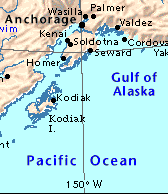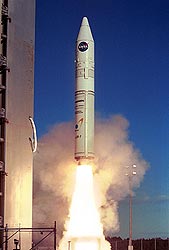 The first launch from America's new Kodiak Island launch site in Alaska was an Athena-I rocket boosting the so-called Kodiak Star payload of four satellites on September 30, 2001.
The first launch from America's new Kodiak Island launch site in Alaska was an Athena-I rocket boosting the so-called Kodiak Star payload of four satellites on September 30, 2001.
The launch had been delayed several times due to high solar flare activity and travel delays resulting from the shutdown of airline traffic following the September 11, 2001, terrorist attacks in New York, Washington and Pennsylvania.
Geography. Kodiak Island is a volcanic peak in the ocean some 30 miles off the southern coast of the state of Alaska in the Gulf of Alaska. About 14,000 people live on the hilly, almost-treeless island.
History. Discovered in 1763 by a Russian fur trader, Kodiak was settled in 1784 by Grigory Ivanovich Shelekhov, who founded a Russian colony at Three Saints Bay. It remained under Russian jurisdiction until 1867, when the United States purchased Alaska. It became a center for whaling in the 19th century. Today the primary occupation for island residents is fishing, although dairy farming is also important.
Things changed somwhat when the Alaska Aerospace Development Corporation (AADC) built its Kodiak Launch Complex on the island.
 Kodiak Launch Complex. KLC is the newest commercial launch complex in the United States, located on Narrow Cape, of Kodiak Island, Alaska, approximately 41 miles south of the city of Kodiak and 250 miles south of Anchorage.
Kodiak Launch Complex. KLC is the newest commercial launch complex in the United States, located on Narrow Cape, of Kodiak Island, Alaska, approximately 41 miles south of the city of Kodiak and 250 miles south of Anchorage.
AADC built the launch complex and operates it. The advantage of the location is a wide-open launch corridor and an unobstructed down-range flight path. The location is ideal for launching expendable launch vehicles with payloads requiring low-Earth polar sun-synchronous orbits.
NASA's launch complex. Kennedy Space Center in Florida in 1998 become the lead center responsible for NASA's acquisition and management of the Expendable Launch Vehicle (ELV) Launch Services Program. The program provides launch services for NASA and NASA-sponsored payloads from these launch sites:
- Cape Canaveral Air Force Station, Florida
- Vandenberg Air Force Base, California
- Kwajalein Atoll in the Pacific
- Wallops Flight Facility, Virginia
- Kodiak Island, Alaska.
Athena History. The Athena launch vehicle program began in January 1993. Athena is a core component of the Lockheed Martin Astronautics family of launch vehicles, which also includes the Titan-4, Titan-2, Multi-Service Launch System, Atlas-2/3, Atlas-5 and Proton vehicles.
The first successful launch of an Athena-I delivered the NASA-sponsored Lewis satellite into orbit from Vandenberg Air Force Base, California, on Aug. 22, 1997.
The first successful launch of an Athena-2 carried NASA's Lunar Prospector spacecraft, on a mission to study the moon, from Cape Canaveral Air Force Station, Florida, on Jan. 6, 1998.
The most recent Athena launch had been Sept. 24, 1999, from Vandenberg, carrying the IKONOS-2 satellite for Space Imaging.
 Kodiak Star payloads. Kodiak Star carried four satellites to Earth orbit. They were the NASA-sponsored Starshine-3 and three satellites sponsored by the Department of Defense Space Test Program (STP) -- PICOSat, PCSat and Sapphire.
Kodiak Star payloads. Kodiak Star carried four satellites to Earth orbit. They were the NASA-sponsored Starshine-3 and three satellites sponsored by the Department of Defense Space Test Program (STP) -- PICOSat, PCSat and Sapphire.
Each satellite required a specific orbit so the Athena-1 rocket maneuvered through two separate orbits. It released the STP satellites at an altitude of 497 miles and Starshine 3 at an altitude of 310 miles.
Amateur Radio satellites. The satellites in the Kodiak Starload payload included the Amateur Radio APRS-equipped PCSat, built by midshipmen at the US Naval Academy. Two others also were hamsats -- Starshine 3 and Sapphire.
PCsat. The Prototype Communications Satellite (PCSat) was intended to be the first in a line of experimental satellites designed, constructed and tested by midshipmen of the United States Naval Academy. PCSat's function was to serve as a position/status reporting and message communications satellite for remote travelers using only hand-held or mobile radios.
In orbit, PCSat augmented the existing worldwide terrestrial Amateur Radio Automatic Position Reporting System (APRS) by providing links from 90 percent of the Earth's surface not covered by the terrestrial network.
Sapphire. Sapphire, carrying a voice replay transmitter, was a joint effort between the Naval Academy's Small Satellite Program, Stanford University and Washington University at St. Louis.
Sapphire was built by Space Systems Development Laboratory of Stanford. It also was operated by United States Naval Academy midshipmen.
Sapphire carried several experiments into orbit including a Beacon Monitoring Experiment, a Tunneling Horizon Detector and a voice synthesizer microchip that converted text messages into a synthesized human voice to allow it to speak to listeners on Amateur Radio frequencies.
Starshine-3. Starshine-3 was a disco-style mirror ball in space with a transmitter. It was intended to be visible to the eye and give earthbound students the opportunity to participate in its primary mission of satellite tracking.
Starshine-3 was a student-built spacecraft developed by the Rocky Mountain NASA Space Grant Consortium and the Naval Research Laboratory.
The satellite was a one-meter optically reflective sphere that weighed 220 pounds. It was covered with 1,500 aluminum mirrors each one inch in diameter. The mirrors were machined by technology students in Utah, with the grinding and polishing of the mirrors by students in kindergarten through twelfth grade in schools all over the world.
Once Starshine-3 was in orbit, students tracked it with the naked eye. They then determined its coordinates and recorded them on the Starshine Project Internet Web site. The resulting data provided scientists with new knowledge about how Earth's upper atmosphere reacts to fluctuations in the Sun's ultraviolet radiation during a sunspot cycle.
That knowledge helps NASA improve forecasts of satellite orbit decay and help astronauts more precisely perform debris avoidance maneuvers for the International Space Station and vehicles in the space shuttle fleet.
Launching Starshine-3 from the Kodiak Launch Complex at a 67-degree inclination allowed students worldwide -- including northern latitudes such as Alaska, northern Canada, Scandinavia and Russia -- to participate in the project. Worldwide student participation had not been possible on previous Starshine missions launched from space shuttles at lower inclinations.
PICOsat. Space Test Program's PICOSat, built by Surrey Satellite Technology Ltd. in Guildford, United Kingdom, housed four scientific payloads:
- Polymer Battery Experiment (PBEX) tested a flexible polymer battery for applications to space flight;
- Ionospheric Occultation Experiment (IOX) used Global Positioning Satellite (GPS) signals to measure ionospheric properties that impact communications and navigation signals;
- Coherent Electromagnetic Radio Tomagraphy (CERTO) measured electron content of the ionosphere with the beacon signal and ground-based receivers; and
- Ultra-Quiet Platform (OPPEX) demonstrated passive and active vibration control for position-sensitive sensors.
| Spaceports | Rockets | Search STO | STO Cover | Feedback | Questions | © 2003 Space Today Online |